I ordered Donald Millers’ Building a StoryBrand before a trip to Chicago and I ate that book up in the 2 short flights to and from MPLS.
I wanted to read the book slowly, especially considering the challenges Donald lays out for you after each chapter.
I applied the learnings to my brand as Donald asks. That wasn’t easy, all I wanted to do was keep reading.
In reading, Donald helped me create the first iteration of my one-liner.
“Differentiating Brands That Serve Homeowners”
You’ll see the one-liner above the fold on my website pothosadvertising.com
You’ll also notice the one-liner in my Substack bio.
What is the StoryBrand 7-Part Framework?
It’s a format that helps you tell concise, believable, and hard-to-forget stories.
He lays out the magic formula on page 21
Donald writes that too many brands position themselves as the hero in the storytelling process when in reality your customer should be the hero of the story.
If you want to learn more buy the book for yourself or visit Donald Millers’ website storybrand.com
My Learnings
The Automatic Rolodex
When your message is clear and concise customers file your brand in the automatic rolodex in their brain.
They probably don’t need your service now, but you need to differentiate your brand and describe what you do effectively so they file you in the category where you belong.
Donald Miller later writes about the effectiveness and necessity of a drip campaign to maintain this effect. Remind your customers you exist frequently by adding value.
Sportsmanship creates tension
Seth Godin recently spoke about Sportsmanship in a podcast. He argues that it exists in our marketplace. Just like a high school football game nobody wants to see a powerhouse continue to run up the score on the small guys.
Donald Miller spoke about a similar idea without using the word Sportsmanship.
Donald breaks a problem down into 3 motives that drive tension. External, Internal, and Philosophical.
External problems are usually quantitative. Such as sales or wins on a football field. For a mechanic, this might be a check engine light or noises coming from your car.
Internal problems are why it matters to a certain individual. I can’t get to work tomorrow if my car breaks down.
Philosophical problems are what I compare to sportsmanship. In the mechanic example, it’s unfair that anybody wouldn’t be able to get to work.
What problems do your customers face?
If you want to satisfy your customers and turn them into repeat customers be sure to offer resolve for all 3 of these tensions.
Roofing companies often only offer resolve to the leaky roof. Where they fall short is understanding why the client needs the repair. Maybe it’s leaking into the baby’s room or prohibiting access to an external door. You must also understand and address that it’s unfair for anyone to have the roof over their head leaking.
Calls To Action Are Patiently Waiting
Be sure that your call to action is clear and concise. Then, blatantly and aggressively plaster it on your marketing material. We all know this but we can use a reminder. Never create an ad that leaves the viewer or customer questioning what action they could take to advance the process of a transaction.
What Donald Miller helped me learn is that Calls to Action are just patiently waiting. When a customer is ready to move forward be sure they know what to do.
When your call to action is patiently waiting customers can easily use their automatic rolodex to solve their problem with your business.
Fear is Salt
You need to tell people what happens if they don’t solve their problem with you.
However, too much fear and the recipe starts to taste a bit unsettling.
People Want to be Taken Somewhere
Where can you take people? Every good story shows a character being brought somewhere by a guide.
Cast a clear vision about where you can bring your customers otherwise they will choose someone else to take them there.
If You Confuse, You Lose
Donald Miller makes sure to drive this message home throughout the book.
You stand no chance without a clear message.
Start a Newsletter
If you’re reading this on substack you’re already applying a best practice.
This inspires me to continue writing.
PS
Thanks for reading! See you next time.
I learned to always add a PS at the end of longer marketing communication. Sometimes this is all people read. But if they’re interested, they scroll back up for more.




